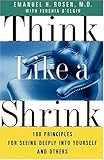Characters are the hearts of our stories. We don't fall in love with plot (usually), we fall in love with the people. So when creating the characters for our stories, we need to pay careful attention to create three-dimensional believable ones. Our characters should have full, rich backstories of why they act the way they do. (Even if this backstory does not make it into the actual book, we need to know it.) If we treat them like real people in our head, then hopefully they will translate as authentic people on the page.
When I start crafting my characters, I often begin with a simple sketch. This usually involves a big circle with the characters name in it, then branching arms as I list their qualities. Very high tech, I know. However, once this is done, I'm only left with a two-dimensional person. Okay, the guy is pig-headed, impatient, paranoid, etc. But why? This is where the work comes in. What made him that way? None of us exist in a vacuum, we are the way we are because of our experiences. So how do you dig deeper and find out?
One day when I was struggling with this, I started rifling through my psyc books from college. Then, I stumbled upon a paperback I bought when I first started interning as a counselor at the college counseling center. I was in panic at the time because I didn't feel prepared to offer people therapy yet, so I started looking for books that would help explain things in layman's terms. A cheat sheet, if you will.
I still feel sorry for those who were subjected to my inexperience during that year. The students knew they were seeing a grad student, but still, I was terrible. My first marriage counseling session with two grad students ended with the guy throwing his wedding ring at his wife (after she admitted to cheating with their roommate) and storming out with a threat of suicide. (I stopped him from leaving with the help of my supervisor, he was alright--although, I wasn't.)

Anyway, I bought the book Think Like a Shrink
to help. (Insert snort at the name--I know.) However, this has now turned out to be an invaluable resource for character backstory building. The chapters are barely a page long and cover the reasons why people act like they do. Some of the title chapters:
Those who don't remember their childhood may want to forget itThe ills of the mothers, or fathers, really are visited upon the childrenBoundaries define people the way borders define countriesThe way people feel about sex is critical to their psychologyWomen do not suffer from penis envy nearly as much as men doNeedy people immediately create chaos in relationshipsDon Juan had an absent fatherAn extramarital affair is less important than what led to itBeware unsolicited denialsWe can tell alot about people by the way they say goodbyeWhat is one the outside is often the exact opposite of what is one the insideVain people marry accessoriesThose who can't get comfortable in their own skin may claw at othersPeople regress to earlier behaviors under stressDoing nothing can be very pushy
I don't agree with everything this guy says. He can be a little Freudian at times, but a lot of it rings true. And anytime I pick it up it gives me great ideas for characters. I highly recommend it.
So what do you do to make your characters three-dimensional? Do you interview them? If so, how do you decide on the answers?